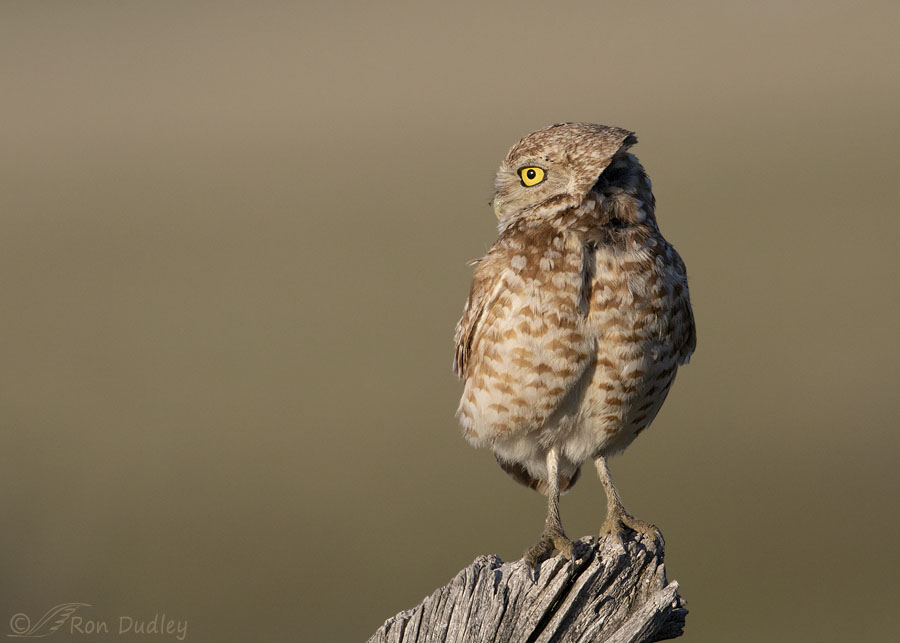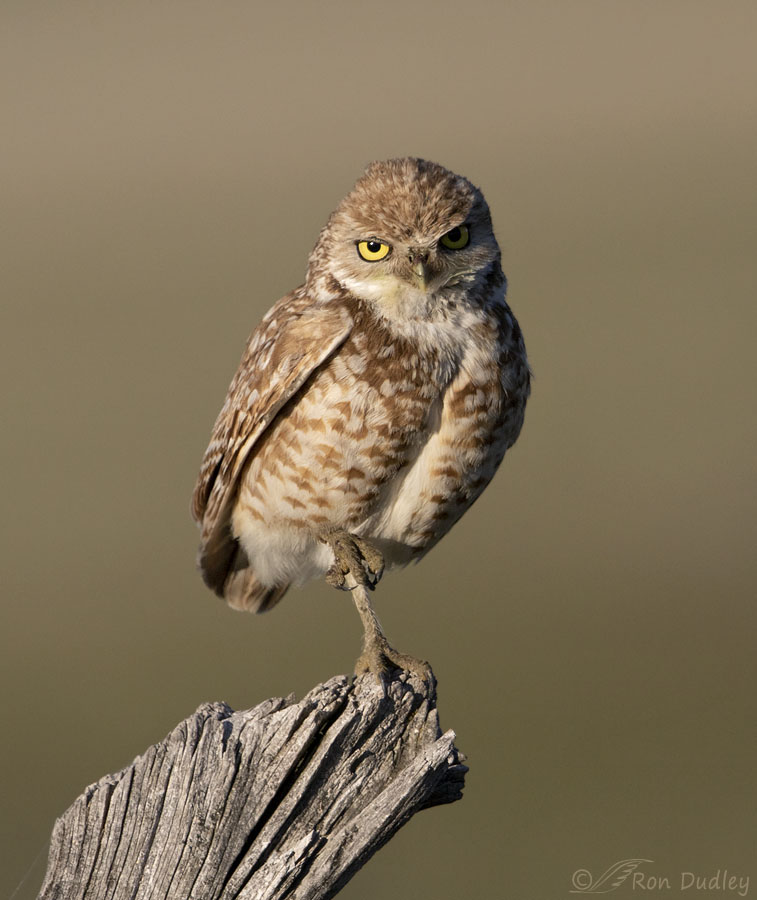If you’re going to dig or maintain a burrow in spring you’re very likely to end up looking a little like a kid who’s been playing in the mud.
For several reasons Florida Burrowing Owls usually excavate their own burrows but their western counterparts rarely do. Instead they take over old burrows of burrowing mammals such as ground squirrels, badgers, prairie dogs, marmots, skunks, prairie dogs, armadillos, kangaroo rats and tortoises.
But our western owls still have to renovate and maintain the burrows by digging. While doing so both sexes dig with their beak and kick backward with their feet.
You can imagine the effect on personal hygiene.

1/4000, f/6.3, ISO 500, Canon 7D Mark II, Canon EF 500mm f/4L IS II USM + EF 1.4 III Extender, not baited, set up or called in
I photographed this owl almost exactly three years ago in Box Elder County. Even though “he” is looking slightly behind him I instinctively took the shot when I noticed a slight wind gust push up some of his head feathers. To me it almost looks like he’s wearing a removeable helmet of some sort.
Notice the caked mud on his feet. In early May it’s likely that he’d been renovating or maintaining his burrow and I believe we’re seeing some of the evidence of that activity.

1/3200, f/6.3, ISO 500, Canon 7D Mark II, Canon EF 500mm f/4L IS II USM + EF 1.4 III Extender, not baited, set up or called in
Even the top of his beak is muddy and it almost looks like he’s about to hide some of the evidence on his right foot by pulling it up into his lower belly plumage.
Besides the corroboration of the digging activities of Burrowing Owls that these photos provide I like the asymmetry of the very old fencepost perch which is part of the reason I cropped this photo as I did.
And of course the owl is a nice touch too.
Ron
Note: I believe I’ve read in the past that the reasons Florida Burrowing Owls dig their own burrows and their western counterparts rarely do are because Florida’s generally sandy soil is easier to dig in and we have far more burrowing mammals and available burrows out west. Please correct me if I’m wrong.


LOVE the second shot!
Can’t wait to see the fruits of your burrowing endeavors, Ron! 🙂
Marty, it’ll be a scaled down garden again this year but I just planted 9 tomato plants. You know me and BLT’s…
More superb photographs of a personal favorite.
Our Florida soil is, indeed, suited to easy digging for owls, but a couple of wildlife biologist friends indicate they would prefer to use old gopher tortoise burrows. The tortoise digs down a bit and then angles the tunnel to help deter flooding. Not to mention, the burrows are usually pretty structurally sound and little renovation is needed. (Not that the Missus won’t request new furniture!)
Great spring time post!
(Note: Our website address has changed.)
Thanks for the heads up, Wally. I’ll try to make the change in my “Blogs I Follow” soon.
I always, always smile when I see these beauties, dirty or not.
And it was good honest dirt anyway (a phrase I suspect many of us have heard in our time).
Thanks Ron.
“good honest dirt” Yep! Know the phrase well! 🙂
Me too, EC.
The first photo is kind of an optical illusion. I can almost see an eye on the right side. Those feet look like my hands these days. Lots of planting in the veggie garden.
You’re right about that phantom eye, Lyle.
As I type this I’m getting veggie garden dirt in my keyboard. Not kidding…
’tis the season! 🙂
I just adore these little guys. I’ve been fortunate enough to find them in NM. And educated by you to stay far away and not disclose their whereabouts. 😇
Yup, disclosing owl locations is almost a guarantee of having them “loved to death” in one form or another.
The second photo composition and the bird pose is fantastic.
Thank you, April.
Cute even if messy! 🙂 Sandy soil vs. our “gumbo” etc. certainly would make a difference as far as digging goes – unless of course our Border Collie is after something……. 😉 Now if I could just get her to dig where I want a hole! The perch is great! They ARE cute no matter what they’re doing! 🙂 Speaking of “playing in the mud” we actually (finally) got .3″ of rain last night – better than a kick in butt…..;) SO hosed out the pickup – our “Big Sky Garage” doesn’t protect things worth a hoot SO since it was already wet! 😉
“Big Sky Garage”
Ha, that’s a new one even for me, Judy.
I actually remember hosing out the inside of some of our farm pickups. Sometimes that’s your only practical choice.
There are times……….. 😉
There’s a nest of burrowing owls near me and I LOVE going to watch them when the kiddos emerge. They’re just so darn CUTE! I hope to find them again this year.
Redtails also do a lot of digging when they’re renovating a used nest, but since they’re digging in sticks, they don’t get real messy. They’ll dig for a while, then wiggle/settle into the nest cup to make sure it’s deep enough. If not, they’ll dig some more until it’s right. Both the male and female dig, although the female has to be satisfied before it’s done. It’s got to be JUST right. Then they line the cup with shredded bark. That was one of the new redtail behaviors I learned from the Cornell hawks several years ago.
It’s amazing how rapidly birds and critters can dissipate a black mood and make everything alright again! They’re really good at it just with their grace of being.
“It’s amazing how rapidly birds and critters can dissipate a black mood and make everything alright again”
Things like that are in very short supply these days. It’s a good thing folks like us have birds to keep us at least semi-sane!
Ron, I absolutely agree with you regarding the Florida Burrowing Owls. So much of Florida’s soil is sandy & I can only think of one burrowing critter – the gopher tortoise. In fact the gopher tortoise is a sentinel animals where other animals will use their burrows when Florida has their forest fires. I haven’t been lucky enough yet to see the burrowing owls but one day I hope to get over the west coast of Florida near Ft. Myers where I know I could see them. Seeing your photos today brings to mind the PBS special where burrowing owls were one of the animals featured along with the Sage Grouse. In fact I think you were the one who alerted me to when it was going to be on. Would love to watch it again!!
Thanks for the confirmation about Florida’s sandy soil, Jo Ann. I believe the PBS special you’re referring to is The Sagebrush Sea.
Nature never ceases to amaze and these guys and gals having to dig with their beaks as well as their feet is a good example. As you say, what an effect on personal hygiene. He or she sure has “Bette Davis Eyes”.
Excellent photos Ron.
Thanks, Everett. For the ear worm too… 🙂